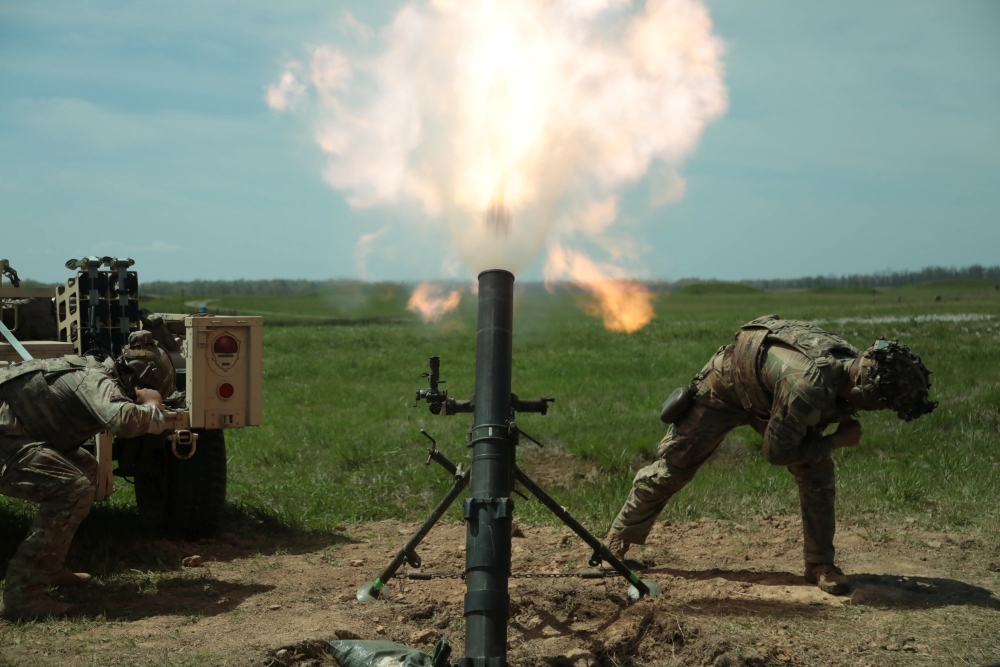
The new type of reconnaissance and strike unit has been in the works for circa 4 years now, evolving in its form and in its tactics, which are still not formalized and written down into doctrine. The driving factors behind this new unit are the observation of trends on the ground in Ukraine and the need to give Infantry Brigade Combat Teams new means to scout. As the Army redesigns for large scale warfighting, it is doing away with IBCT’s Cavalry Squadrons and the old drone units with SHADOW and RAVEN are also being abandoned.
The last MPC experimentation has been conducted by soldiers from 3rd Brigade Combat Team “The Patriots”, from 10th Mountain Division, during Exercise Combined Resolve 25-1 at the Joint Multinational Readiness Centre in Hohenfels, Germany.
For the occasion, the MPC had a strength of circa 80 split into 3 specialised platoons. The first such Platoon, 31-strong, is a Scout platoon heavy on scout snipers and with organic JAVELIN anti-tank missiles as well as Performance Drone Work (PDW) C100 quadcopters. The C100, recently ordered by the US Army as a priority system for infantry companies, is a quadcopter with a carrying capacity of some 10 lbs of modular payloads (when using long endurance battery pack), with an endurance of circa 74 minutes. Backpackable, it is also ready for flight in around 2 minutes. The drone has a fixed camera for First Person View (FPV) flying. Performance Drone Works showcases the C100 also as a potential attack platform capable of dropping small bombs. Range is over 10 km.
The Scout platoon is highly mobile thanks to the use of 9-seats Infantry Squad Vehicles M1301 ISV, a lightweight, unprotected 4x4 supplied by General Motors to ‘motorize’ light infantry and airmobile / air assault units.
A 23-strong mortar platoon supplies heavy firepower via towed 120 mm mortars, using HUMVEEs as prime movers.
A 26-strong Lethal Uncrewed Systems (LUS) platoon is armed with the AeroEnvironment SWITCHBLADE 600 loitering munition. Large numbers of SWITCHBLADE 600 are already being acquired under a number of different contracts and in particular under the Low Altitude Stalking and Strike Ordnance (LASSO) project. The SWITCHBLADE 600 is an evolution of the smaller 300: both munitions are tube-launched and can be easily transported by soldiers in a backpack, but the 600 is heavier and more capable and offers anti-armour capability thanks to the use of the same warhead that is found on the JAVELIN missile. The 600 can reach out to 40 km and fly for around 40 minutes.
The LUS Platoon uses Anduril GHOST uncrewed helicopters. The man-packable GHOST X is powered by 2 swappable batteries giving an endurance of up to 75 minutes with a total payload of 9 kg (circa 20 lbs) and a maximum range that can extend to circa 25 km with optional long-range communications kit. The GHOST is very compact, has a 2-blade rotor and a modular arrangement that enables the swapping of payloads including electro-optic and infrared gimbals, encoded laser options and a vision-based navigation module for flight capability without reference to Global Navigation Satellite System (GNSS). With both batteries fitted, the total weight is 25 kg. Significant numbers have been ordered alongside the C100 mentioned earlier in a dual-supplier award earlier this year.
The LUS Platoon is also tasked with contrast to the enemy’s own drones, being equipped with STINGER MANPADS and with DRONE DEFENDER EW “guns” to jam enemy UAS.
The MPC is completed by a 4-strong organic Electronic Warfare team equipped with the BEAST+ system and a Fire Support Team of 5 to direct supporting Fires and/or air attacks.
Other experimentation with MPCs (also known as Multi-Functional Reconnaissance Companies) is ongoing within 101st Air Assault Division, the “Screaming Eagles”, and within the 25th Infantry Division. In particular, the 2nd BCT, 101 Div has been working with its own special, experimental company.
The base concept is stripping away several layers of command to bring combat power to bear faster to achieve destruction of the enemy. The MPC will operate in front of other formations, scouting and destroying the enemy through movement-to-contact tactics.
Notably, in this latest experiment there has been no use of suicidal First Person View drones, despite FPV attacks being a major feature of the Ukraine conflict.
The new Companies’ mission is to “Sense, Kill, Protect” on behalf of the Brigade.








.png)
